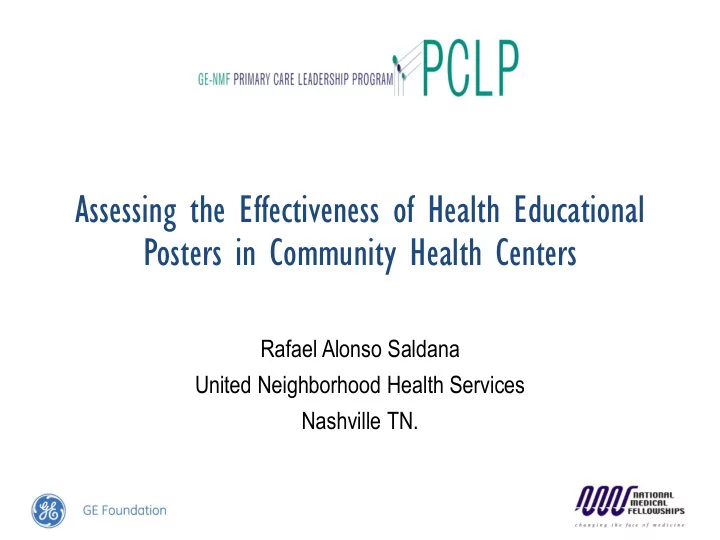

Assessing the Effectiveness of Health Educational Posters in Community Health Centers Rafael Alonso Saldana United Neighborhood Health Services Nashville TN.
Introduction • Patients spend a significant amount of time in waiting rooms, many of them interacting with their smart phones or simply staring down at the floor. • Initial thought was to make use of the time that patients spend in waiting rooms by offering them an opportunity to learn about their health. • With guidance from my academic advisor, Dr. Consuelo Wilkins, the choice to use posters as an educational tool was made: low cost to produce cause no burden on UNHS’s budget or staff’s time
Background • It is estimated that around 85 million people in the U.S. over the age of 13 own a smart phone. • It has been proven that smartphones can play a very important role in patient education and disease self- management. • QR codes are a type of barcode with the ability to encode and decode large amount of information at extremely rapid rates. Increasingly popular amongst the general public Anyone with a smart phone and a special phone application is now able to scan QR codes
Aims • With the intent to take advantage of the time patients spend waiting to be seen clinics, this project used visually attractive, QR code equipped, educational posters displayed in patient and waiting rooms with the following aims: 1) Increase patient knowledge regarding their own health 2) Improve patient adherence to follow up visits 3) Encourage dialog between the patient and physician 4) Asses the patient usage of QR codes
Methodology • Ten Patients were asked to evaluate the pilot poster. They did so by voluntarily filling out an anonymous questionnaire. Asses visual appeal Dialog with physicians Topics of Interest Adherence to follow-up visits Encouragement to learn • All QR codes were individually tracked for usage. The tracking was done through QR Stuff data analysis, a registered trademark of Denso Wave Inc. • The four posters were titled 1) Pilot poster 2) Pilot poster in Spanish 3) Diabetes Management 4) Prenatal health in Spanish. Posters were supplemented with: Facts regarding the importance of disease prevention QR codes which lead to a video or an educational website QR code independent resources like phone applications, websites addresses and toll free phone lines.
Results Topics of Interest Visual Appeal 6 7 5 6 4 5 4 3 3 2 2 1 1 0 0 Diabetes Colorectal Breat Cancer Quiting Not at all Very little Somewhat A lot Extremely Management Cancer Screening Smoking Screening Dialog with Physician Encouragement to Learn Follow-up Visit Adherence 5 4 4 4 3 3 3 2 2 2 1 1 1 0 0 0 Not at all Very little Somewhat A lot Extremely Not at all Very little Somewhat A lot Extremely
Discussion • Project shows promise for continuity and expansion: Positive and encouraging feedback from patients on the open- ended portion of their questionnaire. UNHS staff was very satisfied with the educational materials. UNHS mentioned the possibility of further expanding on the project. • In the one-week period that the QR codes were tracked, they were not used, but this period was relatively brief and longer tracking might provide a larger scope on the potential use for this technology.
Recommendations • The QR codes do not take up a lot of space in the posters and are very easy to create, so they can easily be implemented to posters. • Another aspect to consider is that QR codes are a relatively new technology and if they continue to grow in popularity, their usage may increase. • If UNHS decides to provide patients with free access to wireless Internet in while at their clinics than the QR codes may be more readily utilized.
Conclusion • At this point there is not a big enough sample population to run accurate statistical analysis, but so far the results indicate that a larger majority of people in the study thought the questionnaire was effective than not. This reveals the need to increase sample size and look at broadening the categorical levels.
Acknowledgements • Thanks for making this possible: UNHS The Meharry-Vanderbilt Alliance GE Foundation PCLP
Recommend
More recommend